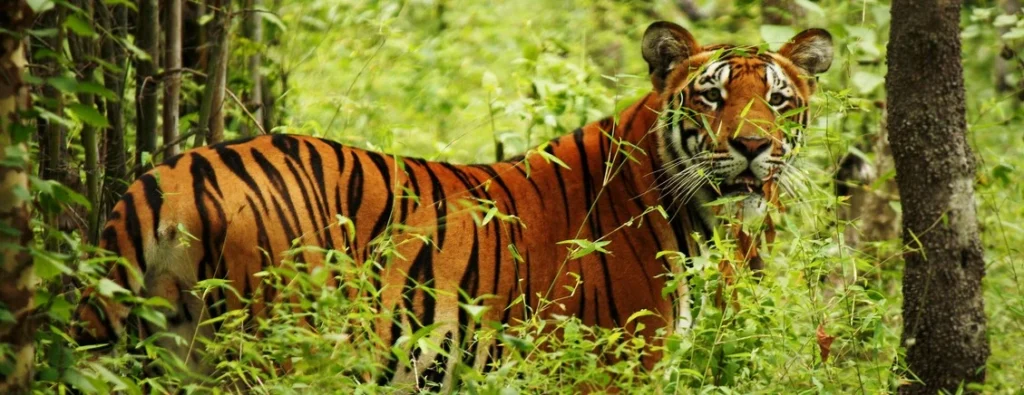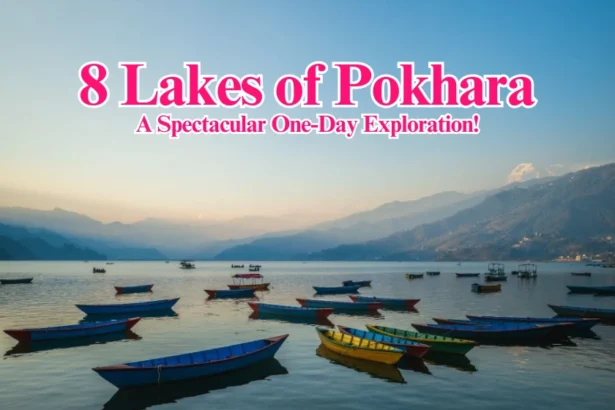Nepal is an incredible destination that is on many tourist’s wishlists. It’s thrilling nature and amazing landscapes are the major reason for the country to be a great holiday destination.
With the variation of landscape throughout the country, the natural resources are distributed equally in each region. The wildlife of every region is protected in wildlife reserves and national parks of Nepal.
From the highest Himalayan range, glacier, lake, and snow-flowing rivers to dense tropical forests and rare wildlife preservation, the National Parks of Nepal have it all.
Here is our list of the National Parks of Nepal that is open to tourists around the world to visit.
You can explore these national parks and wildlife reserves on your next holiday.
Chitwan National Park: First National Park of Nepal

Area(sq.km): 952.63
Established Date: 1973 AD
District: Chitwan, Makawanpur, Parsa
Chitwan National Park is located within the south-central region, specifically in the subtropical lowlands of the inner Terai of Nepal. Tourists visit this national park to witness the wildlife in all its majestic beauty. On a jungle safari in Chitwan National Park, one can see elephants, Bengal tigers, and gaurs.
Elephant breeding centers and Gharial breeding centers are other major attractions for tourists in Chitwan.
Best time to visit: October- early December
Flora: Chitwan National Park consists of tropical and sub-tropical forests. 50 different types of grasses grow here.
Fauna: 50 mammal species, over 525 birds, and 55 amphibians and reptiles
Endangered species: One-horned rhinoceros, Gaur, Royal Bengal tiger Wild elephant, four-horned antelope, pangolin, golden monitor lizard, Python, etc. Bengal florican. Lesser florican, giant hornbill, Black stork, white stork, more.
Koshi Tappu Wildlife Reserve
Area(sq.km): 176.00
Established Date: 1976 AD
District: Sunsari
One of the best places to experience wildlife is the Koshi Tappu Wildlife Reserve. Although wild buffalos are the prime attraction here, one can also spot other species of animals such as deer, bulls, boars, and pythons. Apart from animals, birds here are also worth the admiration, in total, over 400 species of birds are found in the forests of Koshi Tappu. The Koshi River adds to the beauty of the landscape in this area.
Best time to visit: October – January
Flora: tall grasses, different types of trees such as reed, kapok, cattail, and more
Fauna:
Animals: wild buffalo; 20 other animal species such as hog deer, wild boar, spotted deer, blue bull, and rock python.
Birds: 441 species of birds (14 endemic species), 20 duck species, white-tailed stonechat, striated marsh warbler, 30 shore birds, 114 water birds, and the endangered swamp partridge and Bengal florican
Fish: The Koshi River is home to 80 species of fish, the endangered Gharial crocodile, and dolphin.
If you are wanting to learn more about Nepal, please check our previous blog.
Langtang National Park

Area(sq.km): 1710.00
Established Date: 1976 AD
District: Rasuwa, Nuwakot, Sindhupalchowk
Langtang National Park is the land of beauty, in order to explore the national park, three different trekking routes are available. Trekking trails here are Langtang Valley, Helambu, and Gosaikunda Lake. All the trekking routes have the facilities of hotels, lodges, tea and coffee shops, and campgrounds.
National and international tourists trek in this area to connect with nature. Solo trekking is popular in this area.
Best time to visit: August
Flora: Various species of rhododendron, chirpine, sal, oak
Fauna:
Animal: Musk deer, Himalayan tahr, red panda, Himalayan black bear, snow leopard, wild dog, ghoral, and serow
Fish: 250 species of birds
Makalu Barun National Park: Hidden Valley of Nepal

Area(sq.km): 1500.00
Established Date: 1992 AD
District: Sankhusabha, Solukhumbu
Makalu Barun National Park is a mountain lover’s delight. From tropical forests along the Arun River to icy mountain summits, Nepal’s Makalu-Barun National Park has it all. You have an unending vista of the tallest mountains in Nepal. You get the clearest view of Mount Everest, Mt. Makalu, Mt. Baruntse, Mt. Lhotse, Mera Peak, and other mountains.
Trekking is the most common way to explore this area.
Best time to visit: late September to early November
Flora: Orchids, bamboo, oak, primrose, fodder trees and more
Fauna: Snow leopard, red panda, musk deer, wild boar, and more
Rara National Park: Smallest National Nark of Nepal

Area(sq.km): 106.00
Established Date: 1976 AD
District: Mugu, Jumla
Rara National Park is the smallest and most unique national park in Nepal. Preservation of natural habitat is untouched and in its purest state. It protects the representative flora and fauna of the Humla-Jumla region.
The view of Rara Lake and the panoramic view of the landscape is to die for from Rara National Park.
You will witness villages around the Rara National Park. The villagers charm trekkers with their warm smiles and unique lifestyle.
Best time to visit: September, October, April, May
Flora: Pine, birch, rhododendron, hemlock, oak, juniper, and spruce
Fauna:
Animals: Musk deer, Himalayan black bear, Leopard, Jackel, Himalayan Tahr, Red panda, Rhesus macaque, and more.
Birds: 214 species of birds.
Sagarmatha National Park: Land of Mount Everest

Area(sq.km): 1148.00
Established Date: 1976
District: Solukhumbu
Sagarmatha National Park stands out among the other national parks of Nepal. This area is a UNESCO World Heritage Site, as it consists of the world’s highest mountain, Mt.Everest. The other subject to be listed as a World Heritage Site is the iconic beauty of a high mountain range, glaciers, and preserved natural heritage.
The beauty of Sagarmatha National Park comprises the upper catchment areas of the Dudhkoshi and Bhotehoshi Rivers and the rugged terrain and gorges of the high Himalayan Range of the world.
If you are interested in exploring Sagarmatha National Park, there are various trekking trails.
Best time to visit: March-May, October and November
Flora: juniper, birch, rhododendron, scrub and alpine plant communities, pine, and hemlock trees, and many more
Fauna: red panda, snow leopard, musk deer, Himalayan tahr, marten, Himalayan mouse hare
Birds: 118 species of birds, including the Impeyan pheasant, snow cock, blood pheasant, and red-billed cough.
Dhorpatan Hunting Reserve: Only Hunting Reserve in Nepal

Area(sq.km): 1325
Established Date: 1983 AD
District: Baglung, Myagdi, and Rukum
Dhorpatan Hunting Reserve is the only hunting reserve in Nepal. This beautiful area consists of snow-capped mountains to flat meadows. If you decide to trek or visit Dhorpatan, you will witness a remote area and the lifestyle of the people there, the view of Mt. Dhaulagiri and Mt. Annapurna, and the cultural heritage around the Annapurna and Dhaulagiri regions.
Game hunting is possible for licensed hunters in controlled areas. Hunting certain species in specific areas is the way to go here. It is not that expensive to take part in game hunting in this reserve. A significant number of visitors arrive by helicopter from Kathmandu to take part in hunting activities within the Dhorpatan Hunting Reserve.
If you are seeking some thrill to practice game hunting, Dhorpatan Hunting Reserve is the next best destination for you.
Best time to visit: September-December and March-June
Flora: pine, birch, rhododendron, hemlock, oak, juniper, and spruce
Fauna: leopard, goral, serow, Himalayan tahr, Himalayan black bear, barking deer, wild boar, blue sheep, Rhesus macaque, langur, and mouse hare
Endangered animals: Musk deer, wolf, red panda, cheer pheasant, and Danphe
Birds: 137 different species of birds are found in the forest of Dhorpatan.
Conclusion
There are lists of various wildlife reserves and national parks of Nepal. From jungle safaris to the Everest summit, everything is possible in Nepal.
When looking for the best holiday experience, look no further than the national parks of Nepal to witness the beauty of nature, the culture, history, and lifestyle of Nepalis.
We hope our guide helps you plan your next holiday!!
Frequently Asked Questions (FAQ’s)
Is hunting allowed in the Dhorpatan hunting reserve?
Yes, licensed hunting is possible in Dhorpatan Hunting Reserve, Nepal. Hunting requires a proper license issued by the Department of National Parks and Wildlife Reserves.
Which is the Biggest Wildlife Reserve of Nepal?
The Annapurna Conservation Area, established in 1992, is the biggest wildlife reserve in Nepal. This area consists of the Annapurna Himalayan Range, Kali Gandaki River Valley. 100-plus species of mammals and 50-plus species of plants are found in this area. Some of the endangered animals preserved here are the snow leopard, musk deer, Tibetan argali, and Tibetan wolf.
Total National Parks of Nepal.
There are 12 national parks in Nepal, and apart from national parks, various other wildlife preservation areas are designated here. Other protected areas include 6 conservation areas, 1 wildlife reserve, and 1 hunting reserve in Nepal. These projected areas cover 23% of Nepal’s land.
Is Nepal safe for solo travelers?
Yes, Nepal is safe for solo travelers, female solo traveling is also practiced here. If you choose Nepal as your next holiday destination, you can visit and explore the various possibilities of nature, culture, history, heritage, adventurous activities, and more by yourself. Various solo trekking trails are also present in Nepal.




